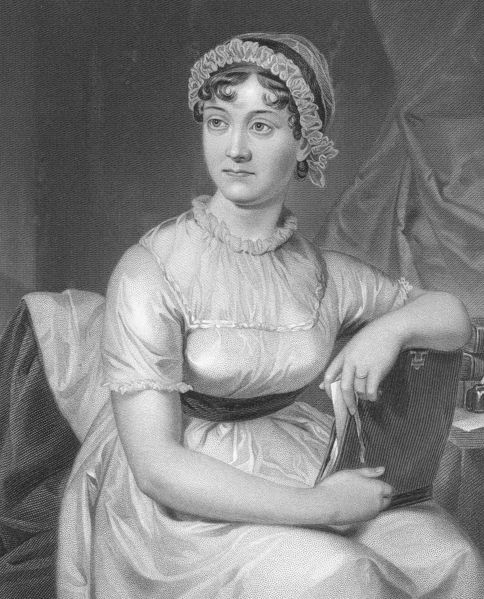|
|
 发表于 2009-12-16 08:58:24
|
显示全部楼层
发表于 2009-12-16 08:58:24
|
显示全部楼层
1775年12月16日: Jane Austen, English novelist, Jane Austen was born on 16 December, 1775, at the rectory in the village of Steventon, near Basingstoke, in Hampshire.

A watercolour and pencil sketch of Jane Austen, believed to be drawn from life by her sister Cassandra (c. 1810). By courtesy of the National Portrait Gallery, London
Jane Austen was a major English novelist, whose brilliantly witty, elegantly structured satirical fiction marks the transition in English literature from 18th century neo-classicism to 19th century romanticism.
Jane Austen was born on 16 December, 1775, at the rectory in the village of Steventon, near Basingstoke, in Hampshire. The seventh of eight children of the Reverend George Austen and his wife, Cassandra, she was educated mainly at home and never lived apart from her family. She had a happy childhood amongst all her brothers and the other boys who lodged with the family and whom Mr Austen tutored. From her older sister, Cassandra, she was inseparable. To amuse themselves, the children wrote and performed plays and charades, and even as a little girl Jane was encouraged to write. The reading that she did of the books in her father's extensive library provided material for the short satirical sketches she wrote as a girl.
At the age of 14 she wrote her first novel, Love and Freindship (sic) and then A History of England by a partial, prejudiced and ignorant Historian, together with other very amusing juvenilia. In her early twenties Jane Austen wrote the novels that were later to be re-worked and published as Sense and Sensibility, Pride and Prejudice and Northanger Abbey. She also began a novel called The Watsons which was never completed.
As a young woman Jane enjoyed dancing (an activity which features frequently in her novels) and she attended balls in many of the great houses of the neighbourhood. She loved the country, enjoyed long country walks, and had many Hampshire friends. It therefore came as a considerable shock when her parents suddenly announced in 1801 that the family would be moving away to Bath. Mr Austen gave the Steventon living to his son James and retired to Bath with his wife and two daughters. The next four years were difficult ones for Jane Austen. She disliked the confines of a busy town and missed her Steventon life. After her father's death in 1805, his widow and daughters also suffered financial difficulties and were forced to rely on the charity of the Austen sons. It was also at this time that, while on holiday in the West country, Jane fell in love, and when the young man died, she was deeply upset. Later she accepted a proposal of marriage from Harris Bigg-Wither, a wealthy landowner and brother to some of her closest friends, but she changed her mind the next morning and was greatly upset by the whole episode.
After the death of Mr Austen, the Austen ladies moved to Southampton to share the home of Jane's naval brother Frank and his wife Mary. There were occasional visits to London, where Jane stayed with her favourite brother Henry, at that time a prosperous banker, and where she enjoyed visits to the theatre and art exhibitions. However, she wrote little in Bath and nothing at all in Southampton.
Then, in July, 1809, on her brother Edward offering his mother and sisters a permanent home on his Chawton estate, the Austen ladies moved back to their beloved Hampshire countryside. It was a small but comfortable house, with a pretty garden, and most importantly it provided the settled home which Jane Austen needed in order to write. In the seven and a half years that she lived in this house, she revised Sense and Sensibility and Pride and Prejudice and published them ( in 1811 and 1813) and then embarked on a period of intense productivity. Mansfield Park came out in 1814, followed by Emma in 1816 and she completed Persuasion (which was published together with Northanger Abbey in 1818, the year after her death). None of the books published in her life-time had her name on them — they were described as being written "By a Lady". In the winter of 1816 she started Sanditon, but illness prevented its completion.
Jane Austen had contracted Addisons Disease, a tubercular disease of the kidneys (see Jane Austen's Illness by Sir Zachary Cope, British Medical Journal, 18 July 1964 and Australian Addisons Disease Assoc.). No longer able to walk far, she used to drive out in a little donkey carriage which can still be seen at the Jane Austen Museum at Chawton. By May 1817 she was so ill that she and Cassandra, to be near Jane's physician, rented rooms in Winchester. Tragically, there was then no cure and Jane Austen died in her sister's arms in the early hours of 18 July, 1817. She was 41 years old. She is buried in Winchester Cathedral.
评论:英国小说家。 |
|